Navigation
Commuting Bicyclists: A Growing Transportation Trend
Biking is gaining popularity as a form of commuting which benefits the environment.
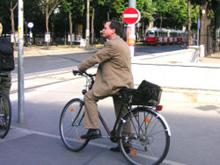 |
| Bicycle commuter in Vienna, Austria. |
Biking is gaining popularity as a form of commuting which benefits the environment. Joe Lindsey’s article on www.bicycling.com says that bike commuting saves 20 pounds of CO2 for every gallon of gas that is not burned by driving to the office. With an estimated 3.2 million cyclists commuting to work in the U.S. at least once a week, which represents a 100% increase since 1985 according to the Seattle Department of Transportation (DOT), the country is experiencing a return to a more environmentally-friendly form of transportation.
In an article noting the cycling trend, the Environmental Defense Fund (EDF) remarked that early in the 20th Century bicycling to work or to do errands was common in the United States. However, car use rapidly accelerated in the 1950s and 1960s based on innovative automotive designs combined with the new high-speed Interstate Highway System which was heavily subsidized through federal funding. By 1990, the Federal Highway Administration called bicycling and walking "the forgotten modes" of transportation. Federal funding for bicycling and walking projects rapidly increased from $6 million in 1990 to $422 million by 2003, according to EDF, and the 2005 federal transportation bill dedicated $1 billion to bicycling alone.
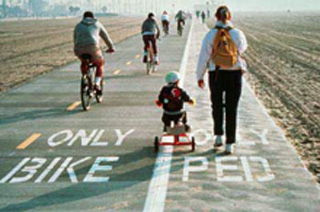 |
| Long Beach California. www.pedbikeimages.org Photographer Dan Burden |
One of the most important environmental benefits of biking is decreased global warming. The EDF suggests that if everyone who lives within 5 miles of their workplace left their car at home just one day a week and cycled to work, nearly 5 million tons of global warming pollution would be saved every year. That is the equivalent of removing approximately one million cars from the road, notes the EDF.
Conscientious people in many parts of the world are returning to bicycling as a means of transportation rather than just for recreation.
The top spot in the world for commuting bicyclists, according to The Bicycle Friendly Communities Campaign, is Amsterdam, Netherlands, a.k.a. the bike capital of the world, where 40% of all traffic movement is by bicycle.
In the U.S., the city of Davis, California has more bikes than cars and is the only place to earn platinum status on the Bicycle Friendly Communities' list of top cities.
In San Francisco about 40,000 residents commute to work regularly by bicycle, according to Virgin Vacations which has listed top bicycle cities in the world. Virgin Vacations also says that another western U.S. city that is consistently rated as one of the top spots in the country for bicycling is Seattle.
The Seattle Department of Transportation estimates that about 36% of Seattle's 520,000 citizens engage in recreational bicycling, and between 4,000 and 8,000 people commute by bicycle in Seattle each day, depending on the time of year and weather conditions.
Steve Cole, a Portland resident who frequents Seattle, notes that “downtown Seattle and the inner city neighborhoods have primarily commuter cyclists, messengers, and delivery cyclists.” A fan of city living, Steve adds that” having dense cities with healthy neighborhoods, with streets on a grid-system where there are shops, restaurants, and stores in the area makes it easier to bike and walk places, which results in a more vibrant, friendly city.”
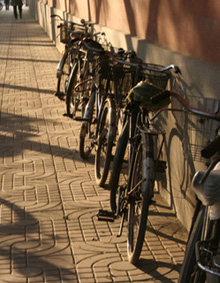 |
| Bikes in Beijing China Photo by Sasha Meret |
In the 21st Century, lifestyles are becoming more environmentally oriented says CBN news.
For example, Shanghai aims to build the world's first eco-city called Dongtan on Chongming Island, in the East China Sea. This joint program of the Chinese and British governments will feature bicycle paths and walkways crisscrossing the city as well as battery-powered buses.
Bicycling provides benefits in addition to helping the environment. It is a good form of exercise. In an article by Paul Strand in CBN News he states that biking 30 minutes a day meets the daily exercise requirements for healthy living and fights obesity.
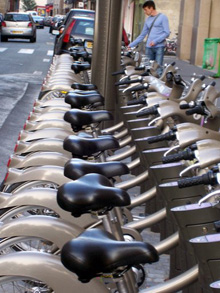 |
| Paris bike rentals started a year ago. The first half hour rental is free. |
In a list of bicycle facts and statistics provided by the Seattle DOT, it is suggested that a 130-pound cyclist who pedals 14 miles in an hour burns 402 calories. For a 180-pound cyclist in the same time and distance, 540 calories are burned. That offsets a lot of chocolate!
Bikes are much less costly to purchase than cars, as well as having much decreased maintenance cost, no gas costs and infrequent parking fees. A report by CBN News estimated that the average car costs about $7,000 a year to own and operate, whereas biking costs just about $120. That results in a savings of about $500 a month.
Another benefit cited by the Seattle DOT is that it can take the same amount of time, or less, to commute on a bike during rush hour than to drive to work.
The increased popularity of bicycle use for commuting has been motivated, in part, by government support.
Portland, Oregon has a network of bike paths that has grown from 60 to 260 miles since the early 1990s. The paths connect all parts of the city and, according to the Bicycle Friendly Communities, have contributed to the quadrupled growth in bicycle use during that period of time.
Mr. Cole who is married with young children notes that there are combination bike/pedestrian paths, bike boulevards which allow for cars but include traffic-calming devices that give bikes priority, and dedicated bike lanes on busier thoroughfares.
Families often avoid the bike lanes because they are on busier streets. Boulder, Colorado has spent an average 15% of its transportation budget on building and maintaining bicycle traffic over the past five years according to Virgin Vacations.
In a further effort to motivate people to use bicycles new innovative programs are being implemented. For example:
In the United States:
- Portland, Oregon has the Portland's Create-a-Commuter program which provides low-income adults with commuter bicycles as well as a session on commuter safety. The bikes come outfitted with lights, a lock, a helmet, a pump, tool kits, maps and rainwear.
- In Boulder, Colorado, the Boulder Safe Routes to School pilot program promotes safe biking and encourages its use. One school reported that 75 percent of their students walked or biked to school — a 620 percent increase from before the pilot!
- New York City’s Mayor Michael Bloomberg recently unveiled a bold plan for greening the Big Apple, and one of the "greenprint's" big initiatives is to cut global warming pollution by 30 percent by 2030. According to EDF, in order to help meet that goal and to make the city's air healthier, the plan's transportation component includes an 1,800-mile bike path master plan to encourage cycling, along with congestion pricing and expanding mass transit.
- Chicago’s Bike 2015 Plan, announced in 2006, outlines a bevy of projects and policies to promote bicycling in the Windy City over the next decade.
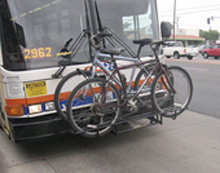
A transit bus's bike rack in use. Midway City, CA, USA Photo Wikipedia - Seattle (DOT) Bicycle Program has been working steadily toward developing an urban trail system to accommodate bicyclists. Urban trails include shared use paths, bike lanes, signed bike routes, arterials with wide shoulders, and pedestrian pathways. Also, bike racks have been installed on the front of all public buses, providing a convenient way to "bike-and-ride." It is estimated by the DOT that the number of times cyclists put their bikes on Metro buses every year is more than 300,000.
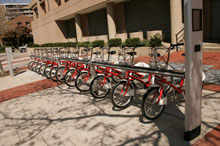 |
| Clear Channel Outdoor's Biking program in Barcelona, Spain Credits of photos: Clear Channel Outdoor. |
In Washington, DC, Clear Channel Outdoor is launching a Smartbike Program in mid-May 2008 which will be the country’s first public bike sharing program. It is pursuant to the existing bus shelter contract the company has with the District of Columbia.
“Operational for over a decade throughout Europe, SmartBikes will provide an exciting new means of public transportation available from bike stations that the company has installed and will maintain at 10 key locations throughout Washington, D.C.,” according to Clear Channel. Martina Schmidt, President of Clear Channel Adshel said, “Practical and lightweight, the SmartBikes to be unveiled at the kick off event will offer a new form of mobility, complementing Washington, D.C.’s existing transportation networks.”
“The SmartBike program delivers a number of key benefits, chief among them the ability to reduce traffic congestion and pollution,” Clear Channel said. Users can sign up for the SmartBike program through online subscription or by calling Clear Channel Outdoor’s service center (1-800-899-4449).
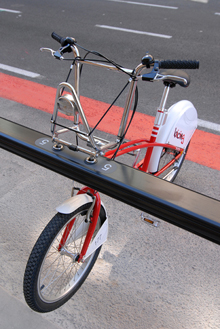 |
| Clear Channel Outdoor's Biking program in Barcelona, Spain Credits of photos: Clear Channel Outdoor. |
The Washington program is an extension of bike programs operated by Clear Channel all of which the company says have proven to be a success.
The company says that nearly eight million trips have been taken on the bikes by a combination of some 180,000 users. It is estimated that in total over 25 million miles have been traveled on public bikes operated by Clear Channel Outdoor.
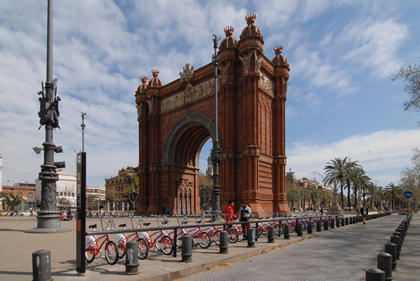 |
| Clear Channel Outdoor's Biking program in Barcelona, Spain Credits of photos: Clear Channel Outdoor. |
“SmartBike has experienced incredible success as a preferred method of public transportation in European markets like Barcelona, where over 100,000 people have now registered to participate. It’s exciting to launch the first U.S. program in our nation’s capital,” said Paul Meyer, President and Chief Operating Officer for Clear Channel Outdoor. “Our SmartBike programs also provide a fantastic sponsorship opportunity for health conscious, sporting and active lifestyle brands.”
In Copenhagen, Denmark:
- Public bicycles are provided throughout the downtown area and used with a returnable deposit of 20 kroner. It was known as “the city of bikes” for many years. Currently 32% of Copenhagen workers bicycle to work and, according to Virgin Vacations, 50 percent of people in Copenhagen say they cycle to work because it is fast and easy.
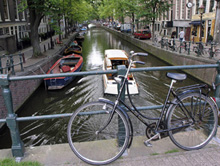 |
| Bike in Amsterdam Photo by Sean McClean |
Safety
One of the concerns people have about commuting by bicycle is the risk of accidents. The Seattle DOT reports that head injuries cause about three-fourths of the 800-900 deaths resulting from bicycling-related accidents in the U.S. each year. In a report by CBN, it was estimated that more than 90 percent of the bicycle accidents in America are caused by collisions with cars or trucks.
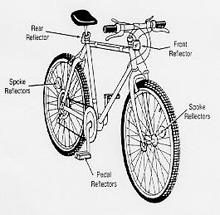 |
| Reflectors for night riding are one of many available safety accessories. Image: Wikipedia |
According to a study conducted by the Harborview Injury Prevention and Research Center, helmets that meet American National Standards Institute or Snell standards can cut the risk of riders' head injuries by 85%. The number of bicyclists wearing a helmet has increased from 71% in 1992 to 89% in 2007, according to the Seattle DOT.
"Bike riding fun should go hand in hand with bike safety. It is important to master these three important bicycle skills before hitting the road:
1. Ride in a straight line
2. Look back without swerving
3. Stop and Control your bike speed.
Keep yourself and your loved ones safe with help from this free bicycle safety guide The Ultimate Bike Safety Guide. By exercisebike.net"
A 2006 study from the World Health Organization (WHO) implicates road design and inadequate pedestrian and cycling infrastructure in injuries from traffic accidents.
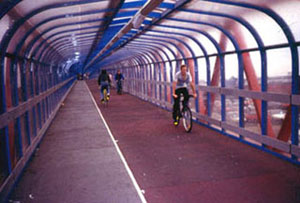 |
| Inside a covered pedestrian and bicycle bridge, Cambridge, England. www.pedbikeimages.org Photographer : Michael Cynecki |
As more cities improve their transportation design and offer more options for walkers and bikers, the WHO reports that these issues are abating.
Paul Strand of CBN News refers to a recent study that showed that during an hour of biking, compared to an hour of driving, people in cars are twice as likely to be killed in an accident as are people on bikes.
Steve Cole said Portland, Oregon is implementing “bike boxes” at dangerous intersections in. These require cars to stop behind the box, which takes up the entirety of the front of the right lane, and reduces incidences of “right hook” accidents, where cars turning right collide with a biker in the adjacent lane.
Contributed link from Boy Scout Conner, a bicycle and pedestrian safety guide: Pedestrian and Bicycle Safety for All Ages https://www.rosenfeldinjurylawyers.com/pedestrian-and-bicycle-safety-for-all-ages.html
Conner's Boy Scout troup are studying safety during the Covid restrictions preventing in person meetings. Posted on the Horizon Interational Solutions Site on October 17, 2020.
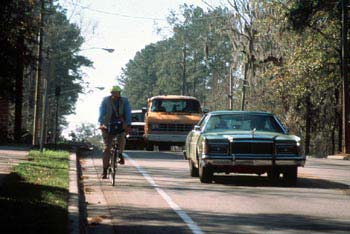 |
| Bike lane California. Photo by Dan Burden |
The large increase in use of bicycles in Portland, Oregon since the 1990s occurred without any increase in crashes according to the Oregon government report on bike safety.
Another issue that governments are battling is bike theft. Places like Amsterdam, Netherlands have built bicycle sheds to “park” one’s bicycle in a safer venue. It is in the process of building a 10,000-bike parking garage at the main train station according to Virgin Vacations list of the most bike friendly cities in the world.
EDF reports that National U.S. polls and surveys indicate that significantly more adults would bike to work if they had safe routes and secure workplace parking and changing facilities.
Raising safety consciousness is a goal of many who are ardent supporters of bicycling as a means of transportation.
In Oregon, the 2007 Legislature approved a Share the Road license plate, which has a picture of a cyclist on the plate and is available for the regular registration plus an additional $10 charges. According to the Oregon DOT, the proceeds are split between the Bicycle Transportation Alliance and Cycle Oregon for use on bicyclist education.
In California, the California Bicycle Coalition (CBC), a non-profit education and lobbying organization, is working to improve bicycling conditions throughout the State of California. CBC's mission is to create safe, healthy and livable communities in California by promoting bicycling for transportation and recreation.
In Colorado, Bicycle Colorado is another organization whose mission is to encourage and promote bicycling, increase safety, improve conditions, and provide a voice for cyclists in Colorado.
National events also have been created to create awareness of biking. The largest of these is the National Bike/Walk to Work Day which is in its fourth year. This year it will be held on Friday, May 16, 2008.
So get your bike out, dust it off, pump up the tires, and get ready to ride!
And see Additional Facts below:
Article by:
Dave Steinmetz, Volunteer and Youth Advisory Board Member
Horizon International
See: Allie, Amy, and David Steinmetz and the "No Butts About it Litter Campaign" which they started on the Horizon Solutions Site for Kids at http://www.solutions-site.org/kids/youth.htm
Photographer Sasha Meret’s work can be seen at www.sashameret.com. Sasha’s artistic renderings of coral reef creatures for Horizon International can be seen on the Magic Porthole Web page at http://www.magicporthole.org/
Sources:
- 2018 Beginners Guide to Cycling https://online.regiscollege.edu/family-nurse-practitioner/healthy-hobby-beginners-guide-cycling/
- 2008 Virgin Vacations http://www.virgin-vacations.com/site_vv/11-most-bike-friendly-cities.asp
- Bicycle Colorado http://www.bicyclecolo.org/
- Bicycle Transportation Alliance http://www.bta4bikes.org/
- California Bicycle Coalition www.calbike.org/
- California Bicycle Coalition (CBC) www.calbike.org
- CBN News http://www.cbn.com/cbnnews/usnews/060712a.aspx
- China Daily March 19, 2008 http://www.china.org.cn/environment/opinions/2008-03/19/content_13074694.htm
- China Internet Information Center www.china.org.cn
- Colorado www.bicyclecolo.org/
- Cycle Oregon http://www.cycleoregon.com/
- Environmental Defense Fund (EDF) http://www.edf.org/article.cfm?contentID=5483
- Harborview Injury Prevention and Research Center www.depts.washington.edu/hiprc
- National Bike/Walk to Work Day http://www.bike2work-day.com/
- Oregon Government DOT http://www.oregon.gov/ODOT/HWY/BIKEPED/
- Seattle (DOT) Bicycle Program www.seattle.gov/transportation/bikeprogram.htm For more information about the Seattle Bicycle & Pedestrian Program, call (206) 684-7583.
- World Health Organization (WHO) http://www.who.int/
- http://www.bicyclefriendlycommunity.org/
- www.bicycling.com/
Additional Facts:
Speed-- Time to Cover One Mile:
From Wikipedia
A cyclist can ride at 12-30+ miles per hour. Depending on the volume of motor vehicle traffic and the distance of the commute, bicycle commuting can be quicker or slower than driving. For longer commutes, a combination strategy using a bicycle and public transit can be effective using a folding bicycle or if local ordinances permit bicycles on the transit system. For commuters that perform cardiovascular exercise on a regular basis, combining the two activities may result in an overall more efficient approach. As Congressman Earl Blumenauer once said: "Let's have a minute's silence for all those Americans who are currently sitting in traffic on the way to the gym to ride a stationary bicycle."
time per mile | ||
30 mph | 48 kph | 2 minutes |
20 mph | 32 kph | 3 minutes |
15 mph | 24 kph | 4 minutes |
12 mph | 19 kph | 5 minutes |
Historical Notes on Bicycles:
From Wikipedia:
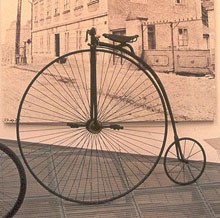 |
| Ordinary bicycle |
While the Starley design was much safer, the return to smaller wheels made for a bumpy ride. The next innovations increased comfort and ushered in the 1890s Golden Age of Bicycles. In 1888, Scotsman John Boyd Dunlop introduced the pneumatic tire, which soon became universal. Soon after, the rear freewheel was developed, enabling the rider to coast without the pedals spinning out of control. This refinement led to the 1898 invention of coaster brakes. Derailleur gears and hand-operated, cable-pull brakes were also developed during these years, but were only slowly adopted by casual riders. By the turn of the century, bicycling clubs flourished on both sides of the Atlantic, and touring and racing were soon extremely popular.
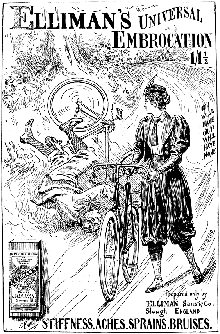 |
| Ellimans Universal Embrocation Slough 1897 |
Several inventors and innovators contributed to the development of the bicycle. Its earliest known forebears were called velocipedes, and included many types of human-powered vehicles. One of these, the scooter-like dandy horse of the French Comte de Sivrac, dating to 1790, was long cited as the earliest bicycle. Most bicycle historians now believe that these hobbyhorses with no steering mechanism probably never existed, but were made up by Louis Baudry de Saunier, a 19th-century French bicycle historian. However, the term hobbyhorse was later applied to the first documented ancestor of the modern bicycle, first introduced to the public in Paris by the German Baron Karl Drais in 1818.[citation needed].
The ancestor of the bicycle was first created by a German Baron, Karl Drais, who invented and patented his machine in 1817. So the first bicycle ride was from his residence town Mannheim to the suburb Rheinau. A number of these draisines or dandy horses still exist, including one at the Paleis het Loo museum in Apeldoorn, the Netherlands. These were pushbikes, powered by the action of the rider's feet pushing against the ground. The Draisienne had two in-line wheels connected by a wooden frame. The rider sat astride and pushed it along with his feet, while steering the front wheel.
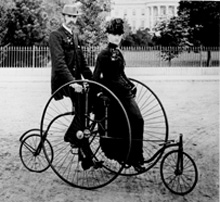 |
| 1886 quadricycle for two. Smartly dressed couple seated on an 1886-model quadracycle for two. The South Portico of the White House, Washington, D.C., in the background.Photo Wikipedia English: Ordinary bicycle, Skoda Museum, Mlada Boleslav, Chech Republic, photo by: Agnieszka Kwiecieñ Nova, |
Scottish blacksmith Kirkpatrick MacMillan refined this in 1839 by adding a mechanical crank drive to the rear wheel, thus creating the first true "bicycle" in the modern sense. His system employed a pair of treadle drives connected by rods to a rear wheel crank, rather like a steam locomotive's driveshaft. Although the design was copied by at least two other Scottish builders, it was overtaken in popularity and influence by an inferior one.
In the 1850s and 1860s, Frenchmen Ernest Michaux and Pierre Lallement took bicycle design in a different direction, placing the pedals on an enlarged front wheel. Their creation, which came to be called the "Boneshaker", featured a heavy steel frame on which they mounted wooden wheels with iron tires. Lallement emigrated to the United States, where he recorded a patent on his bicycle in 1866 in New Haven, Connecticut. The Boneshaker was further refined by Englishman James Starley in the 1870s. He mounted the seat more squarely over the pedals so that the rider could push more firmly, and further enlarged the front wheel to increase the potential for speed. With tires of solid rubber, his machine became known as the ordinary. British cyclists likened the disparity in size of the two wheels to their coinage, nicknaming it the penny-farthing. The primitive bicycles of this generation were difficult to ride, and the high seat and poor weight distribution made for dangerous falls.
NOTE:
Links with detailed information are available on the Horizon Solutions Site:
The categories are:
Agriculture, Air Pollution, Biodiversity, Desertification, Energy, the Environment, Global Climate Change, Human Rights, Industry, Population, Poverty, Public Health, Sustainable Development, Transportation, Waste Management, Water, Organizations and Foundations, Research and Information, Web Directories and other Media, and Horizon Solutions Site Collaborators
Brought to you by Horizon International.
 |
The Horizon Solutions Site http://www.solutions-site.org/ is a finalist in the Stockholm Challenge 2008.
![]()
Search
Latest articles
Agriculture
- World Water Week: Healthy ecosystems essential to human health: from coronavirus to malnutrition Online session Wednesday 24 August 17:00-18:20
- World Water Week: Healthy ecosystems essential to human health: from coronavirus to malnutrition Online session Wednesday 24 August 17:00-18:20
Air Pollution
- "Water and Sanitation-Related Diseases and the Changing Environment: Challenges, Interventions, and Preventive Measures" Volume 2 Is Now Available
- Global Innovation Exchange Co-Created by Horizon International, USAID, Bill and Melinda Gates Foundation and Others
Biodiversity
- It is time for international mobilization against climate change
- World Water Week: Healthy ecosystems essential to human health: from coronavirus to malnutrition Online session Wednesday 24 August 17:00-18:20
Desertification
- World Water Week: Healthy ecosystems essential to human health: from coronavirus to malnutrition Online session Wednesday 24 August 17:00-18:20
- UN Food Systems Summit Receives Over 1,200 Ideas to Help Meet Sustainable Development Goals
Endangered Species
- Mangrove Action Project Collaborates to Restore and Preserve Mangrove Ecosystems
- Coral Research in Palau offers a “Glimmer of Hope”
Energy
- Global Innovation Exchange Co-Created by Horizon International, USAID, Bill and Melinda Gates Foundation and Others
- Wildlife Preservation in Southeast Nova Scotia
Exhibits
- Global Innovation Exchange Co-Created by Horizon International, USAID, Bill and Melinda Gates Foundation and Others
- Coral Reefs
Forests
- NASA Satellites Reveal Major Shifts in Global Freshwater Updated June 2020
- Global Innovation Exchange Co-Created by Horizon International, USAID, Bill and Melinda Gates Foundation and Others
Global Climate Change
- It is time for international mobilization against climate change
- It is time for international mobilization against climate change
Global Health
- World Water Week: Healthy ecosystems essential to human health: from coronavirus to malnutrition Online session Wednesday 24 August 17:00-18:20
- More than 400 schoolgirls, family and teachers rescued from Afghanistan by small coalition
Industry
- "Water and Sanitation-Related Diseases and the Changing Environment: Challenges, Interventions, and Preventive Measures" Volume 2 Is Now Available
- Global Innovation Exchange Co-Created by Horizon International, USAID, Bill and Melinda Gates Foundation and Others
Natural Disaster Relief
- STOP ATTACKS ON HEALTH CARE IN UKRAINE
- Global Innovation Exchange Co-Created by Horizon International, USAID, Bill and Melinda Gates Foundation and Others
News and Special Reports
- World Water Week: Healthy ecosystems essential to human health: from coronavirus to malnutrition Online session Wednesday 24 August 17:00-18:20
- STOP ATTACKS ON HEALTH CARE IN UKRAINE
Oceans, Coral Reefs
- World Water Week: Healthy ecosystems essential to human health: from coronavirus to malnutrition Online session Wednesday 24 August 17:00-18:20
- Mangrove Action Project Collaborates to Restore and Preserve Mangrove Ecosystems
Pollution
- Zakaria Ouedraogo of Burkina Faso Produces Film “Nzoue Fiyen: Water Not Drinkable”
- "Water and Sanitation-Related Diseases and the Changing Environment: Challenges, Interventions, and Preventive Measures" Volume 2 Is Now Available
Population
- "Water and Sanitation-Related Diseases and the Changing Environment: Challenges, Interventions, and Preventive Measures" Volume 2 Is Now Available
- "Water and Sanitation-Related Diseases and the Changing Environment: Challenges, Interventions, and Preventive Measures" Volume 2 Is Now Available
Public Health
- Honouring the visionary behind India’s sanitation revolution
- Honouring the visionary behind India’s sanitation revolution
Rivers
- World Water Week: Healthy ecosystems essential to human health: from coronavirus to malnutrition Online session Wednesday 24 August 17:00-18:20
- Mangrove Action Project Collaborates to Restore and Preserve Mangrove Ecosystems
Sanitation
- Honouring the visionary behind India’s sanitation revolution
- Honouring the visionary behind India’s sanitation revolution
Toxic Chemicals
- "Water and Sanitation-Related Diseases and the Changing Environment: Challenges, Interventions, and Preventive Measures" Volume 2 Is Now Available
- Actions to Prevent Polluted Drinking Water in the United States
Transportation
- "Water and Sanitation-Related Diseases and the Changing Environment: Challenges, Interventions, and Preventive Measures" Volume 2 Is Now Available
- Urbanization Provides Opportunities for Transition to a Green Economy, Says New Report
Waste Management
- Honouring the visionary behind India’s sanitation revolution
- Honouring the visionary behind India’s sanitation revolution
Water
- Honouring the visionary behind India’s sanitation revolution
- Honouring the visionary behind India’s sanitation revolution
Water and Sanitation
- Honouring the visionary behind India’s sanitation revolution
- Honouring the visionary behind India’s sanitation revolution


